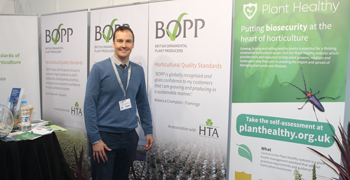Talking Horticulture with Rachel Anderson

How a simple checklist can help avoid horticultural casualties
In a desperate attempt to resuscitate my organisational skills, I’ve just downloaded a checklist app. For, what I didn’t realise until I attended a talk by the Horticultural Trades Association (HTA)’s horticulture manager, Alistair Yeomans, is the amazing difference that using a simple checklist can make to our lives. In fact, they can even save lives. And so, at a time when pests and diseases such as Xylella fastidiosa and the oak processionary moth (OPM) have the potential to flatline the horticulture supply chain, the use of checklists could prevent valuable plant stock from being ambulanced out of your nursery on a stretcher.

Alistair Yeomans, HTA
Speaking at this year’s National Plant Show, Alistair highlighted the findings of the surgeon and public health professor, Atul Gawande. Atul was asked by the World Health Organisation (WHO) to examine why, despite medics’ high level of specialism, operating theatres still experience complications and death rates. Atul examined what other high-risk industries, such as the skyscraper construction and the aviation world, do – and discovered that (that’s right, you’ve guessed it) they all use checklists. And, low and behold, when he implemented checklists in eight different hospitals across the world, their complication rates fell by 35% and their death rates fell by 47% per cent.
Fortunately for the ornamental horticulture sector, a helpful checklist has already come to the rescue in the form of the HTA’s free Plant Healthy Risk Assessment (planthealthy.org.uk). This “biosecurity health check” is essentially the HTA’s new Plant Health Management Standard (PHMS) * transformed into a checklist format. The PHMS is list of 23 voluntary requirements that have been designed to help horticulture businesses improve their plant health and biosecurity practices. As Alistair pointed out: “Standards are ultimately checklists that enable you to look at your business and see if you are doing the right things.” Plant Healthy can also help prepare growers for the EU’s forthcoming Plant Health Regulation. This is because the new legislation places a strong emphasis on pest risk management plans, staff training, and traceability. With this in mind, the scope of plant passports will be extended to all plants for planting and the information on them will include:
- the details of plants received – species, quantity, date
- the identity of the supplier
- the number of copies of passports issued
- the details of the plants sold – species, quantity, date.
- who the purchaser was
- copy of passport issued
- a traceability code on the plant passport
The new legislation is being rolled out over the coming year – with most of the regulations coming into effect on December 14 (2019) (regardless of whether or not the UK leaves the EU). Arguably, these tighter measures are well timed and will help prevent further horticultural casualties in Europe. After all, Xylella has reportedly now spread to olive trees in nearby France and the UK government has been forced to introduce national measures to prevent the further spread of the hazardous OPM. So, if you haven’t already, perhaps it’s time to join me in welcoming checklists into your working lives.
*The PHMS standard is providing the backbone of a new assurance scheme that will help growers know that the plants they have produced and handled are bio-secure and have been grown and sourced responsibly.
